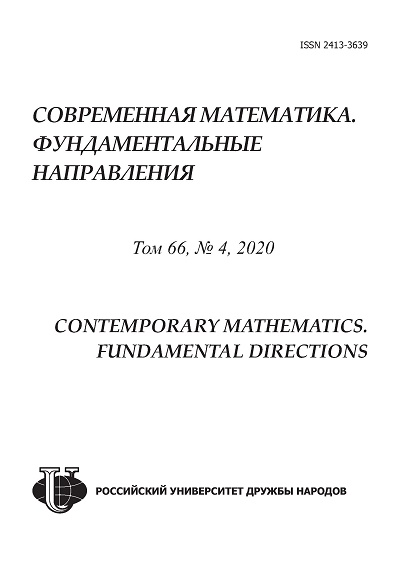Vol 66, No 4 (2020): Algebra, Geometry, and Topology
- Year: 2020
- Articles: 3
- URL: https://journals.rudn.ru/CMFD/issue/view/1408
- DOI: https://doi.org/10.22363/2413-3639-2020-66-4
Full Issue
Articles
Coding Knots by T-Graphs
Abstract
In this paper, knots are considered as smooth embeddings of a circle into 3 defined by their flat diagrams. We propose a new method of coding knots by T-graphs describing the torsion structure on a flat diagram. For this method of coding, we introduce conceptions of a cycle and a block and describe transformations of T-graphs under the first and the third Reidemeister moves applied to the flat diagram of a knot.
 531-543
531-543


Analytic Detection in Homotopy Groups of Smooth Manifolds
Abstract
In this paper, for the mapping of a sphere into a compact orientable manifold , we solve the problem of determining whether it represents a nontrivial element in the homotopy group of the manifold πn(M ). For this purpose, we consistently use the theory of iterated integrals developed by K.-T. Chen. It should be noted that the iterated integrals as repeated integration were previously meaningfully used by Lappo-Danilevsky to represent solutions of systems of linear differential equations and by Whitehead for the analytical description of the Hopf invariant for mappings . We give a brief description of Chen’s theory, representing Whitehead’s and Haefliger’s formulas for the Hopf invariant and generalized Hopf invariant. Examples of calculating these invariants using the technique of iterated integrals are given. Further, it is shown how one can detect any element of the fundamental group of a Riemann surface using iterated integrals of holomorphic forms. This required to prove that the intersection of the terms of the lower central series of the fundamental group of a Riemann surface is a unit group.
 544-557
544-557


Volumes of Polyhedra in Non-Euclidean Spaces of Constant Curvature
Abstract
Computation of the volumes of polyhedra is a classical geometry problem known since ancient mathematics and preserving its importance until present time. Deriving volume formulas for 3-dimensional non-Euclidean polyhedra of a given combinatorial type is a very difficult problem. Nowadays, it is fully solved for a tetrahedron, the most simple polyhedron in the combinatorial sense. However, it is well known that for a polyhedron of a special type its volume formula becomes much simpler. This fact was noted by Lobachevsky who found the volume of the so-called ideal tetrahedron in hyperbolic space (all vertices of this tetrahedron are on the absolute).In this survey, we present main results on volumes of arbitrary non-Euclidean tetrahedra and polyhedra of special types (both tetrahedra and polyhedra of more complex combinatorial structure) in 3-dimensional spherical and hyperbolic spaces of constant curvature K = 1 and K = -1, respectively. Moreover, we consider the new method by Sabitov for computation of volumes in hyperbolic space (described by the Poincare´ model in upper half-space). This method allows one to derive explicit volume formulas for polyhedra of arbitrary dimension in terms of coordinates of vertices. Considering main volume formulas for non-Euclidean polyhedra, we will give proofs (or sketches of proofs) for them. This will help the reader to get an idea of basic methods for computation of volumes of bodies in non-Euclidean spaces of constant curvature.
 558-679
558-679












